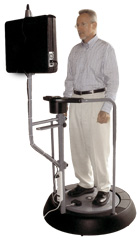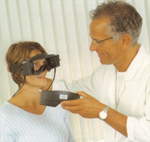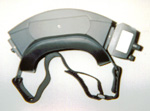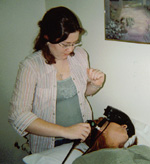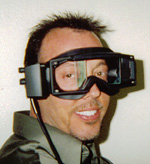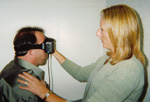How to Find the Right VNG
& Therapy System
The VideoNystagmography (VNG), Posturography and Balance Therapy systems are clinical tools that offer a diagnostic evaluation and assessment of the vestibular system. Unfortunately there are now systems being sold that are over-priced and do not offer a full-clinical software package. Secure Balance™ was carefully designed to exceed the clinical and government standards for vestibular function testing (VNG) and balance rehabilitation. Our experienced group of neurotologists, otolaryngologists, audiologists, Internists and Chiropractors has assisted in the development of the Secure Balance™ program in order to provide the most effective and reasonably priced system. When you decide to invest in this type of program you should consider the following:
2005 JCAHO Requirements
The Free-Field Advantage in VideonystagmographyTesting
Utilizing the Secure Balance™ System
A Compact and Mobile VNG System
FDA(510k)
Is the VNG Software HIPAA Compliant?
What is HIPAA?
Clinically Accepted VNG Testing Methods
Balance Therapy
Acceptable Billing Criteria
Color Coded Reports that Include Normative Values
Calibration-Free Systems
Report Builder
Clinical Training
On-Site Installation & Training
2005 JCAHO Requirements
Secure Balance™ is helping you with compliance to the 2005 JCAHO requirements !
All health care providers and organizations are expected to comply with the National Patient Safety Goals (NPSG) as set forth by the Joint Commission on Accreditation of Healthcare Organizations (JCAHO). One of the 2005 NPSG is to “Reduce the risk of patient injury due to falls.” Specifically JCAHO is requiring the health care organizations to perform the following functions:
- Assess and periodically reassess each patient’s risk for falling; including the potential risk associated with the patient’s medication regimen and take action to address any identified risks.
- Implement a fall reduction program, including a transfer protocol and evaluate the effectiveness of the program.
Visit the JCAHO website at www.jcaho.com
The Free-Field Advantage in VideonystagmographyTesting Utilizing the Secure Balance™ System
Randolph McKenzie, M.D., F.A.C.S.
(Leading Expert in Vestibular Science)
In the ten plus years following the availability of video-oculography by way of the use of low emission infra-red systems, the clinical assessment of balance disorders from both qualitative and quantitative information has dramatically changed the face of the advance of this science. Videonystagmography or VNG has provided the solution to limitations in technique of previous analysis of electronystagmography (ENG). Video images of the eyes can now be obtained without direct contact utilizing high-resolution infra-red cameras based primarily on “stealth technology”. Simultaneous visualization of the eyes during dynamic movement can be analyzed by digital imaging processing providing for recording of both horizontal and vertical eye movement.
More recently, multiple VNG systems have appeared on the market, each with their respective advantages and limitations. Most recently, the Secure Balance™ systems have emerged utilizing a full or free-field of vision technology. This has allowed for more in-depth analysis of nystagmus with an accuracy of .10 degrees. Utilizing the Goggle or “COMBIMASK” (combination mask), patients during tracking and saccade testing were not just following a light on a computer screen, but rather able to follow real world targets such as colors, images of a boy on a bicycle, etc. Tracking and saccade testing are markedly enhanced by the full-field feature. For optokinetic testing, this system allowed for a sense of immersion in the optokinetic stimuli providing for more accurate testing. The full field system additionally enabled rotational testing to be done in the setting of formal rotary chair conditions. Lastly, positional testing could be recorded and documented without producing distracting artifacts.
Other features of the COMBIMASK provided for visual observation of nystagmus in both eyes, easy adjustment for anatomical variations in interpupillary distance and focus, enhanced built-in fixation lights and excellent fitting for patients with smaller head dimensions. It also provided for a lack of testing in a totally darkened room and a light occluding cover which is easily applied or removed during testing. This system can also be used as stand-alone video Frenzel lenses. The COMBIMASK was developed as an extraordinarily light system facilitating technician application and patient friendliness for comfort.
The software system provides for the ability to customize examination templates, to view graphic data and corresponding eye positions, to perform fast statistical analysis according to age-matched normative data and to apply assorted stimulus patterns for the various sections of the VNG. This system also provides for fast calibration and easy modification for varying test chamber spaces. Lastly, it provides for hands-free operation with a user-friendly foot switch. Test data is generated at optimal speed, greatly reducing time consuming steps involved in generating this data.
The Secure Balance™ systems appear to have combined the most sophisticated hardware and software technology available today. It is clearly a state-of-the-art system which can be used with confidence in any balance lab setting.
A Compact and Mobile VNG System
Secure Balance™ is the most compact and mobile system that offers a full-clinical testing format. There are systems being sold today that cost more and claim that their systems are more compact and mobile. Their more expensive package is not a full-clinical system that offers a full-clinical software package. A full-clinical system should provide full-field peripheral stimulation for all oculomotor function testing, inclusive of tracking, gaze, saccades and optokenetics (OPK) with a stimulus that moves in all directions. Full-field testing is the ONLY method that will provide you with a full clinical CNS evaluation of the vestibular system. The “on-screen” stimuli offered by the sub-clinical systems only offer less equipment and not necessarily a true and accurate diagnosis of the vestibular system. The Secure Balance™ system provides the full-clinical software package and comes with a small lightweight projector that projects a full-field target for a complete and accurate diagnosis of the vestibular system. The projector is smaller than a text book and weighs about a pound. Medicare is now investigating some of these other VNG systems and their unofficial claims. DON’T LET THE OTHERS FOOL YOU !
FDA(510k)
The Secure Balance™ systems have been issued the FDA(510k). They also include the European CE mark and ISO standards. It is your responsibility to assure that you have a recent copy of the FDA(510k) that indicates an FDA evaluation of the system you are going to purchase. There may be systems being sold that have been modified or drastically changed and have not been issued an updated FDA(510k). In these cases the FDA(510k) MUST indicate that it is for that particular system and not an older version. You may be looking at upgraded VNG systems that have fewer components and modified clinical software that have not been issued the FDA(510k). LESS COMPONENTS IS NOT AN INDICATION THAT THE FDA HAS DETERMINED THAT THE DEVICE CAN BE MARKETED. A MANUFACTURER HAS THE RESPONSIBILITY TO ADVISE THE FDA OF HARDWARE AND SOFTWARE CHANGES. THE SYSTEM MUST HAVE BEEN ISSUED THE FDA(510k) TO BE ELIGIBLE FOR BILLING.
Is the VNG Software HIPAA Compliant?
The Secure Balance™ VNG clinical software is HIPAA compliant. There are systems being sold that are not HIPAA compliant, and this is a violation of HIPAA regulations. MAKE SURE THE VNG SOFTWARE IS HIPAA COMPLIANT.
All medical diagnostic software, including VNG software, must include licensing and security codes in order to protect the patient information.
It is your responsibility to assure that the VNG software you are purchasing includes security licensing and password protection to secure patient information in accordance to HIPAA regulations.
The Secure Balance™ VNG software provides HIPAA compliance.
What is HIPAA?
 The Health Insurance Portability and Accountability Act of 1996 (HIPAA), was the result of efforts by the Clinton Administration and congressional healthcare reform proponents to reform healthcare. The goals and objectives of this legislation are to streamline industry inefficiencies, reduce paperwork, and make it easier to detect and prosecute fraud and abuse and enable workers of all professions to change jobs, even if they (or family members) had pre-existing medical conditions.
The Health Insurance Portability and Accountability Act of 1996 (HIPAA), was the result of efforts by the Clinton Administration and congressional healthcare reform proponents to reform healthcare. The goals and objectives of this legislation are to streamline industry inefficiencies, reduce paperwork, and make it easier to detect and prosecute fraud and abuse and enable workers of all professions to change jobs, even if they (or family members) had pre-existing medical conditions.
The HIPAA legislation had four primary objectives:
- Assure health insurance portability by eliminating job-lock due to pre-existing medical conditions
- Reduce healthcare fraud and abuse
- Enforce standards for health information
- Guarantee security and privacy of health information
Clinically Accepted VNG Testing Methods
The Secure Balance™ systems offer full-clinical methods for testing. This includes full-field stimuli, full clinical software for positional, caloric and oculomotor testing. Be aware of VNG software features that offer an “on-screen” stimuli. This is a system that presents a stimulus or target on a small computer screen. This is a poor method of presenting tracking, saccades and optokenetics (OPK). This method is considered “sub-clinical”. They may even claim that there is no calibration. That is a false claim. This type of stimuli only offers limited movement and tracking capability without a necessary and full peripheral stimulus. The “on-screen” stimulus requires sensitive calibration, for example: if the patient is instructed to sit in front of the computer screen or light-bar device, they MUST be at an exact and calibrated distance. The light-bar devices sold in the market today are not full-field and are not as sensitive as the “on-screen” stimulus. The computer screen stimuli have been proven to have an error rate of 40-50%, per a study conducted by the Southeastern Neuroscience Institute. The “on-screen” stimulus requires a tremendous effort from both technician and patient. Any movement, forward or back, as well as side-ways, will grossly distort the data. DO NOT PURCHASE ANY VNG SYSTEM THAT OFFERS A COMPUTER SCREEN STIMULUS.
Balance Therapy
The terms “Posturography”, “Dynamic Posturography”, “Balance Assessment”, and “Balance Therapy” all have different meanings and applications. For the consumer, this becomes a confusing decision when considering a program for your patients. The Secure Balance™ program was carefully designed to maximize patient clinical outcomes and maximize billing. After several years of experience and evaluation of all the manufactured systems, Ingen Technologies decided that a Balance Assessment and Therapy system would be more beneficial with use of the vestibular function testing or VNG. The SportKAT offers the best balance therapy system as a part of the entire rehabilitation protocol. There is NOT one system that offers all of the necessary balance therapy. Therapy and rehabilitation is inclusive of, but not limited to, this type of balance therapy. The Secure Balance™ program provides you with a complete therapy package and protocol. During our investigation of various systems we had noticed that there were others advertising for Dynamic Posturography systems when in fact they were not. YOU CANNOT BILL FOR CPT-92548 UNLESS YOU OWN AND PERFORM A TRUE COMPUTERIZED DYNAMIC POSTUROGRAPHY PROCEDURE. Our Secure Balance™ Therapy system is the most effective system in stimulating positive clinical outcomes for your patient in the shortest amount of time. When you are considering the purchase of a balance therapy system you should consider the following:
- Secure Balance™ comes with hand-Rails that are available and securely attached to the base unit. Some systems sold have hand-rails that are not attached and can cause serious injury to your patients. They will slide forward during rehab.
- The Secure Balance™ floor plate can swivel 360 degrees. Some systems sold use a wooden board mounted on a foam pad. Again, the patient can slip off the board and be injured.
- The firmness of the Secure Balance™ floor plate can be adjusted according to the patient’s weight and protocol. Some systems sold do not offer this feature and their platform cannot be adjusted according to the weight of your patient, or for protocol enhancements. Again, if a heavy patient were to stand on a wooden board mounted on a foam pad, they could slip off and be injured.
- The Secure Balance™ unit can be easily moved from one room to another. The Secure Balance™ Therapy system is a single unit and can simply be tilted and carried away. Some systems sold have several individual components that must be moved separately.
- The Secure Balance™ system provides you with a computer system that is securely attached to the base unit. Some systems sold have a stand alone laptop that can be damaged if the patient were to fall off the wooden board and knock over the computer.
- The Secure Balance™ software provides effective and proven therapy protocols. Our systems have been around for many years. Some systems sold offer protocols that have not been around long enough to consider their effectiveness.
- The Secure Balance™ software is patient friendly and easy to understand. The Secure Balance™ software is easy enough for your patient to use.
The following definitions provide you with a brief definition of the different balance systems sold in the market today:
Computerized Dynamic Posturography testing is performed using a technique originated by Lewis Nashner, who in the early 1970’s developed a method that attempted to isolate the influence of the vestibular labyrinth on the postural control system. These systems include a balance plate and peripheral screen that surrounds the patient, as well as a comprehensive test protocol that measures five identical toes-up and toes-down rotations of the support surface while stimulating the peripheral surroundings. As the balance plate moves, the screen or scenery also moves, thus stimulating the vestibular labyrinth. The price of a Computerized Dynamic Posturography system ranges from $60,000 to $150,000. It should be performed by an experienced audiologist or otolaryngologist. However, the Secure Balance™ VNG test includes a caloric procedure that will also assess the vestibular-ocular system. “Moreover, Dynamic Posturography has the potential to address Balance in the broader sense of standing and walking. As compared with a Rotational Chair test, and certainly as compared with caloric testing, Posturography testing IS NOT nearly as well developed and formalized.” Baloh RW, Honrubia V: Clinical Neurophysiology of the Vestibular System. This system does not offer any therapy protocols, it is definitively diagnostic.
NON-COMPUTERIZED POSTUROGRAPHY systems involve a method in measuring the sway of a patient. YOU CANNOT BILL CPT-92548 FOR THIS PROCEDURE. Some of these systems offer therapy protocols, however make sure that they offer the attributes mentioned above.
Balance Assessment Systems measure the sway through a computer generated tilt sensor. The Secure Balance™ Therapy system uses this advanced technology. This data is recorded and compared with post therapy protocols for measuring improvement in balance. In conjunction with the VNG test, this is the most effective method for measuring improvement.
Balance Therapy systems provide effective training protocols that will train the nerves (propioceptors) that control the muscles of the body that enable the patient to stand, run, jump and otherwise perform day to day functions. The most effective system would include the attributes mentioned above.
Acceptable Billing Criteria
The Secure Balance™ VNG and Balance Therapy systems offer maximum billing components. BE AWARE OF BILLING CHANGES ! Recently Medicare has adjusted the criteria for billing CPT-92546. This code is to be used ONLY for a Rotational Chair Test, and NOT for Active Head Shake. Although Secure Balance™ offers additional methods for testing VOR, the Active Head Shake or AHS is no longer a billable item. Further, make sure that the AHS test produces data for gain, phase and asymmetry, and that it is an acceptable device for measuring VOR. There may be AHS systems that DO NOT actually offer data for gain, phase and asymmetry. Some of these AHS systems require calibration and are distance sensitive. These devices may produce erroneous data and are not an accepted method for measuring VOR. Any AHS system that requires a specific distance between the patient’s eye and the target must require tremendous effort from both the patient and technician. There is no room for error if the distance is incorrect or if the patient moves incorrectly. These problems with AHS could result in serious malpractice liabilities. The AHS and Rotational Chair Tests should only be performed if the full-field oculomotor analysis indicates a possible dysfunction of the VOR, and should only be tested by very experienced audiologists or otolaryngologists.
Color Coded Reports that Include Normative Values
You are spending thousands of dollars for a VNG and balance therapy system. The Secure Balance™ systems offer color reports and normative values that are built into each individual report. You deserve to have the best report that technology can offer. There are VNG systems that do not offer color reporting formats and normative values with each report. They have cut costs and passed on their problems to you. A color report offers a faster and more accurate diagnosis.
Calibration-Free Systems
All VNG and balance systems require some form of calibration. The word calibration is misleading, and some of the slick marketing claims state that their system requires no calibration. That is a false claim. Anytime that the system requires a specified distance between the eye and the stimulus, guess what ?.... that is considered CALIBRATION. What is actually being stated is that a VNG system does not require calibration as compared to an electrode and/or ENG system. Don’t let these claims fool you!
Report Builder
The Secure Balance™ system allows the user to accept a standard report, or build their own report. Find a VNG system that allows you to build or modify the report. This feature comes in handy when you want specific reports for full, partial or modified procedures. Why print an entire report when you only want to retest a patient with a simple Dix-Hallpike ? Why not have special reports for canalith repositioning or the Epley maneuver?
Clinical Training
If you are a physician or clinician you want a training program from experienced individuals. Secure Balance™ offers individual training by Preferred Provider Care in Jacksonville, Florida. Personal tutorials can be obtained by Preferred Provider Care through affiliated Southeast Neuroscience Institute's laboratory. See how you can use this equipment in your neurology practice. You are trained to proficiency by experienced neurotologists. It is the best training program in the world, you will agree.
On-Site Installation & Training
It is important that you receive proper installation and onsite training for your technical staff. Secure Balance™ offers the best installation and training onsite. We spend as much time as required to test the system and train your staff. We test each of your staff for proficiency and accuracy before leaving. If they don’t pass, we don’t leave !

